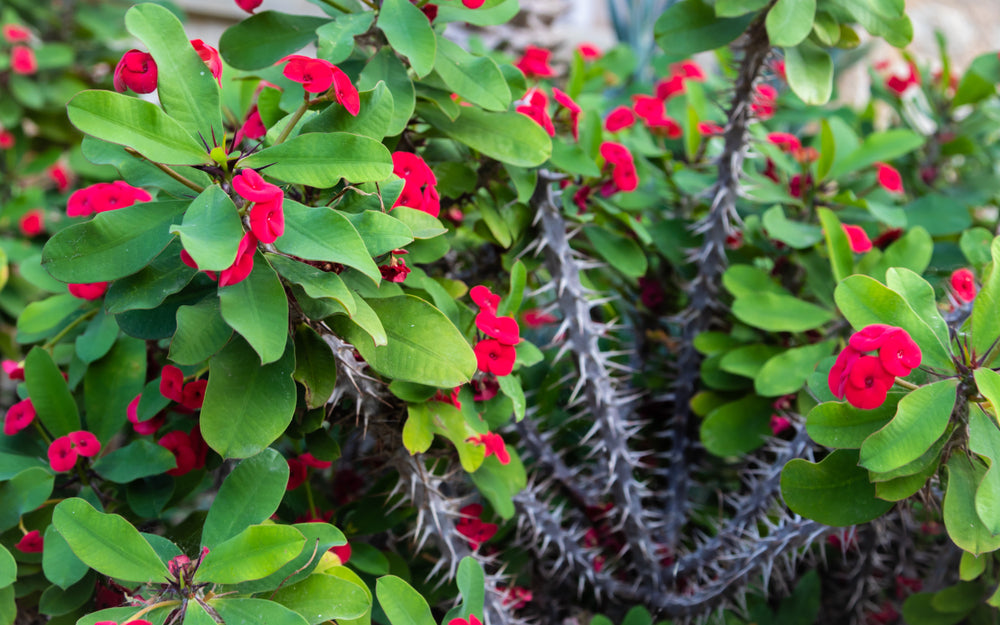Also known as Euphorbia milii, the Christ Thorn is a dangerously beautiful plant that has captured the hearts of plant enthusiasts around the world. Also commonly referred to as the Crown of Thorns plant, Christ Thorn has a rich history, cultural significance, and is admired for its unique appearance and minimal maintenance requirements.
• Origins and Significance of Euphorbia milii:

The Christ Thorn plant traces its origins to Madagascar, where it thrives in arid and tropical climates. This succulent plant belongs to the Euphorbiaceae family and is named after the euphoric milky latex it secretes.
The plant's association with Christ is deeply rooted in Christian tradition, which earns it names like Crown of Thorns plant and Thorn of Christ plant.
According to Christian belief, the Crown of Thorns worn by Jesus during the crucifixion was made from the branches of this plant. As a result, the Christ Thorn holds symbolic significance, representing sacrifice, redemption, and the enduring strength of faith.
• Characteristics of the Christ Thorn:
The Crown of Thorns plant has slender, thorny stems and vibrant green leaves. The thorns are not only symbolic but also serve as a natural defense mechanism against herbivores that may try to eat the plant.
In addition to its symbolic meaning, the plant produces small, colorful Crown of Thorns flower that add to its aesthetic appeal. The Crown of Thorns plant comes in various types and varieties, offering a range of flower colors and forms, from delicate pinks to vibrant reds.
• Benefits of Christ Thorn Plant:

a. Symbolic Significance:
Represents sacrifice, redemption, and the enduring strength of faith in Christian tradition.
b. Adaptability:
Thrives in arid and tropical climates, making it a resilient plant suitable for various environments.
c. Aesthetic Appeal:
Features slender thorny stems, vibrant green leaves, and colorful flowers, adding beauty to gardens and indoor spaces.
d. The Crown of Christ Plant is Low Maintenance:
Requires minimal care, making it an excellent choice for both novice and experienced gardeners.
e. Gardening the Crown of Thorns Cactus Indoors:
Well-suited for indoor gardening, as it can be grown in containers, providing year-round interest and enhancing indoor aesthetics.
f. Air-Purifying Properties:

Acts as an air purifier, helping to filter out pollutants and improve indoor air quality.
g. Drought Tolerance:
Exhibits resilience to drought conditions, allowing it to withstand periods of limited water availability.
h. Long-Lasting Period of Crown of Thorns Plant Flowering:
Produces long-lasting flowers, contributing to the plant's visual appeal over extended periods.
i. Propagating Crown of Thorns Plant:
Easily propagated through stem cuttings, allowing for easy sharing and expansion of the plant collection.
• Myths Surrounding Christ Thorn:
While the Christ Thorn plant is steeped in Christian tradition, there are also myths surrounding its cultivation. Some believe that the plant brings good luck and prosperity to households, while others associate it with protection from negative energy.
• Christ Thorn Plant Care:
1. Light Requirements:
Place the plant in a location with bright, indirect sunlight. It can tolerate some direct sunlight but should be protected from intense, prolonged exposure.
2. Temperature:
Maintain a warm environment, as the Christ Thorn prefers temperatures and protect it from drafts and cold temperatures.
3. Soil:
Use well-draining soil to prevent waterlogging. A cactus or succulent mix works well for Crown of Thorns plants.
Buy Cactus and Succulent Potting Mix
4. Watering:

Allow the soil to dry out between watering sessions. Water sparingly, especially during the dormant winter months, as the plant is drought-tolerant.
5. Humidity:
The plant is adapted to arid conditions and doesn't require high humidity, so your average indoor humidity levels are suitable.
6. Fertilization:
Feed the plant with a balanced, water-soluble fertilizer during the growing season (spring and summer). In the fall and winter, you reduce or even completely stop fertilization.
7. Pruning:
Trim back leggy or unruly growth to maintain a compact shape. Remember to wear gloves when pruning due to the plant's thorns and its irritable sap.
8. Pest Management:
Monitor for pests such as aphids or spider mites. Treat infestations promptly with insecticidal soap or neem oil.
9. Protect from Cold:
If grown outdoors, protect the plant from frost and cold temperatures. Move it indoors during winter in colder climates.
10. Caution with Latex Sap:
Be cautious of the milky latex sap as it can be irritating to the skin and eyes. Wear gloves and wash hands thoroughly after handling the plant.

Whether you are drawn to the Euphorbia milii's symbolic meaning or simply its beauty, the plant is a captivating addition to any garden or indoor space. It also tells us just how well humans and nature can blend if we take care of our surroundings, and respect the differences between all our existences.










